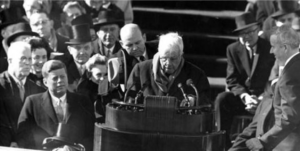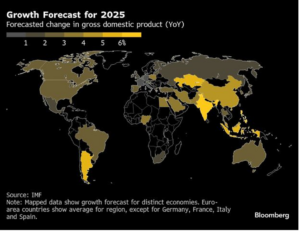Thought of the Week:
In 1961, Robert Frost became the first poet to speak at the inauguration of a president. He recited from memory “The Gift Outright,” when the glare of the sun prevented him from reading “Dedication,” a poem he had written specifically for John F. Kennedy’s inauguration. In Frost’s most famous poem, “The Road Not Taken,” he speaks of two roads diverging in a yellow wood, and says taking the one less traveled has made all the difference. Some take the poem as a salute to can-do individualism, perhaps even American ingenuity; others say, no, because both roads “equally lay,” the poem is really a commentary about how each of us fools ourselves when considering the story of our own lives. When considering how to lobby an incoming administration, rather than blindly taking the path less traveled, it may be better to closely hew to the words of another American poet, Yogi Berra, who famously quipped “When you come to a fork in the road, take it.”

In recent weeks I’ve been asked some version of the same question: what’s the best way to deliver our message or how should we go about building a presence in Washington? Breaking through the noise in Donald Trump’s Washington will most likely require something beyond a single road less traveled. My recommendation: no shortcuts, take Main Street, pave tried and true highways, and, if traffic warrants, look for alternative routes. Among the Main Street basics are introducing oneself to Congressional staffers; drafting and sending effective messages that clearly state the issue in question and how it relates to the constituency; and going further than social media by showing up in person both in Washington and in district with talking points and questions. Paving the way entails reading not just the national news but also a legislator’s local news in order to connect to district and state concerns; preparing one-page legislative briefs to deliver to staffers when lobbying directly; considering stakeholders beyond the legislator himself; structuring an outreach calendar to staff and stakeholders around various themes and dates with plans on how to proactively communicate; maintaining unified messages at both the federal and state levels; considering grassroots strategies beyond direct lobbying; and identifying key events where your message may be amplified. No doubt, there’s always a lot more lobbying traffic at the beginning of a Congress and administration. Among the alternative routes some are considering today are reaching out to the new Department of Government Efficiency (DOGE) and as Politico explains familiarizing themselves with those in President Trump’s inner circle. If your office or unit is considering a trip to Washington, consider letting the D.C. office act as your Waze.
Thought Leadership from our Consultants, Think Tanks, and Trade Associations
Conference Board’s U.S. Economic Forecast. While election uncertainty has lifted, the unpredictability of the incoming administration’s policies still looms. And although the U.S. economy is set to start 2025 on strong footing, after a year of surprisingly robust growth, a combination of proposed policies will likely weigh on growth and leave inflation elevated as the year progresses, resulting in a more patient policy stance from the Federal Reserve (for the time being, the bar is too high for a policy rate increase and a rate cut remains the next policy move). The labor market’s strength will support solid growth in personal income for consumers, and the post-election revival of animal spirits in selected industries will likely contribute to the continuation of strong growth momentum in H1. In addition, some stockpiling behaviors ahead of tariff implementation may temporarily boost both consumer and business purchases in the beginning of the year. However, proposed tariff and immigration policies, if enacted, would weigh on growth, suggesting somewhat slower economic activity in H2. While the extent of implemented tariffs, deregulation, and changes to fiscal policy present material risks, the economy should expand at a 2.3% pace in 2025 with real 2026 GDP growth settling at or slightly below its potential rate. Inflation should continue to normalize toward the Fed’s 2% target, and will stabilize there by the middle of 2026. Against this backdrop, and barring a significant pick-up in inflation on the back of aggressive tariff and immigration policies, the Fed is likely to remain patient and leave rates unchanged in H1 2025, but could resume normalizing policy in July, cutting rates three times by year-end, and the central bank should reach its long-run neutral rate target of 3.00-3.25% by mid-2026.
Eurasia Group Sees Process, Not Pique, Driving Trump’s “Day-One” Trade Policy. Contrary to base case beliefs, President Trump’s Day-One announcements did not include immediate tariff increases. While tariff increases are coming, the timeline now stretches beyond initial expectations of a rollout beginning by late Q1/Q2. Exactly how much delay there will be will vary by nation, with China tariffs likely to move more quickly due to the straightforward legal process in place of expanding existing actions under Section 301. The main thrust of the day one trade agenda was to kick off investigations across the whole of government that will provide both justification for future tariffs and give the White House specific complaints to raise in negotiations with other nations. Regarding China, the official review of the Phase One deal makes explicit what most see as obvious—that Beijing did not comply—and fits with expectations that a rollback of U.S. concessions is in the cards. In fact, Trump has effectively restarted the four-year review of Section 301 action, kicking off the process by which he could choose to increase existing rates. The president’s somewhat offhanded comment about 25% tariffs on Canada and Mexico starting February 1 is more bluster than signal, and seems out of step with the framework that the administration is rolling out, which is a process-heavy approach favored by traditionalists like USTR nominee Greer. This approach discounts the use of emergency authorities, and it lowers the risk of unilateral actions in the first month of the administration. Looking beyond Day One, the most important takeaway was that the Trump team remains committed to tariffs but will go about achieving them in a way that is legally defensible, more durable, and on a timeline that will be determined in part by the responses of threatened nations.
USTR Says China has Evolved into a Predatory Non-Market Economy. Inside U.S. Trade reports that the Office of the U.S. Trade Representative (USTR) says China’s economy has evolved from a centrally planned “socialist market economy” to one that is predatory, a model crafted to displace foreign competitors and dominate production markets—and one that requires evolving U.S. trade tools in response. The determination can be found in USTR’s latest annual report to Congress on China’s World Trade Organization compliance. China’s so-called ‘socialist market economy’ has evolved and turned decidedly predatory in nature,” says the USTR report. In other words, China no longer relies on central planning to direct and guide the business decisions of Chinese industries and enterprises, as do a handful of other non-market economies. Rather, China is unique among them as it uses its state-led, non-market approach to the economy and trade in ways designed to displace foreign competitors and secure the dominance of Chinese enterprises in targeted industries, both in the domestic Chinese market and global markets. China’s economic predation model is different from past industrial planning efforts. For instance, its “industrial targeting”—public support for specific industries—is designed to do more than just establish capable Chinese competitors; rather, the goal is to “aggressively displace foreign competitors.”
Quick Take
Most analysts agree that President Trump’s Day One executive orders and emergency declarations are primarily symbolic, with meaningful regulatory reform likely to take 6-18 months, depending on the agency. The orders reinforce key themes from President Trump’s campaign, including rolling back environmental regulations governing the power and oil & gas sectors and promoting infrastructure development.
“Inside Baseball”
It’s Déjà Vu All Over Again Says the Observatory Group. Although President Trump has said that he is considering 10% tariffs on China starting February 1, his China-specific trade announcements remain softer than previous threats. The new statements seem to be a negotiating tactic before an in-person meeting with President Xi. In terms of Trump priorities, in his call with Xi last week, he mentioned trade imbalances, fentanyl, and TikTok. From China’s perspective, there is room for dealmaking on all these issues. Given the countries’ political calendars, a Trump visit to Beijing could take place in late March or early April, an indication that the U.S. could hold off on new China tariffs until then. However, any meeting could be delayed until June, after Xi’s pre-scheduled visit to Russia in early May. While this could be a move by China to defer the dialogue and continue to avoid new tariffs, the prospective visit recalls the “honeymoon” period between Xi and Trump in 2017, with Xi’s visit to Mar-a-Lago in April and Trump’s reciprocal state visit to Beijing in November of that year. That said, Beijing is still cautious about U.S.-China relations under Trump 2.0, given that Trump is highly unpredictable, and his administration is dominated by China hawks. Chinese officials tend to see Trump’s dovish stance as a negotiating ploy and that tariffs and non-tariff trade actions will eventually follow. Beijing remembers that the 2017 “honeymoon” lasted just 10 months, and a trade war followed immediately after.
In Other Words
“We’re thinking in terms of 25% on Mexico and Canada, because they’re allowing vast numbers of people [across the border]. I think we’ll do it Feb. 1,” President Trump in response to questions in the Oval Office on Inauguration Day.
“The European Union is very, very bad to us. So, they’re going to be in for tariffs. It’s the only way…you’re going to get fairness,” President Trump.
Did You Know
For the second consecutive session, Sen. Cruz (R-TX) and Rep. Norman (R-SC) have introduced a proposed constitutional amendment to enact term limits on members of the House and Senate. Their proposal, which is identical in each chamber, would bar senators from serving more than two terms and House lawmakers from serving more than three terms. While it’s unclear whether the idea will take hold in the 119th Congress, given that it’s historically been favored by Republicans, it could fare better under the GOP majority in both chambers. If lawmakers are successful, a seven-year countdown would begin, in which at least three-quarters of the states would need to ratify the amendment for it to be enshrined in the U.S. Constitution.
According to the Texas State Historical Association, although discovered and circumnavigated by Spanish explorer Sebastián de Ocampo from 1508 to 1509, today’s Gulf of Mexico remained nameless until the 1540s, when it was referred to as the Seno Mexicano—Mexican Inlet or Bay. That name was a play on the word Mexica, which the local indigenous groups used to refer to themselves in Nahuatl. French Jesuits began calling the body of water the Golphe du Mexique, or Gulf of Mexico, as early as 1672.
Graph of the Week
IMF Raises Global Economic Growth Forecast on Stronger U.S. Demand. The International Monetary Fund (IMF) upgraded its global growth forecast for this year, spurred by stronger-than-expected U.S. demand and slowing inflation worldwide that will let central banks continue to cut interest rates. The IMF raised its projection to 3.3%, 0.1% more than its previous forecast in October. It kept the estimate for 2026 unchanged at 3.3%. The improved outlook is largely due to the U.S., which got the biggest upgrade among major economies, rising 0.5% to 2.7%.]
